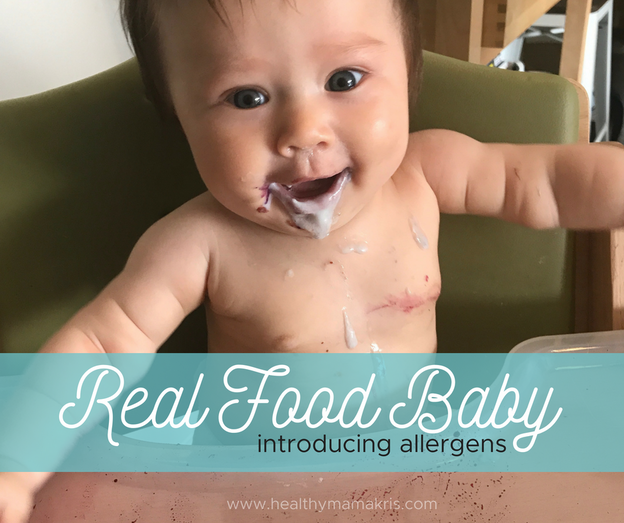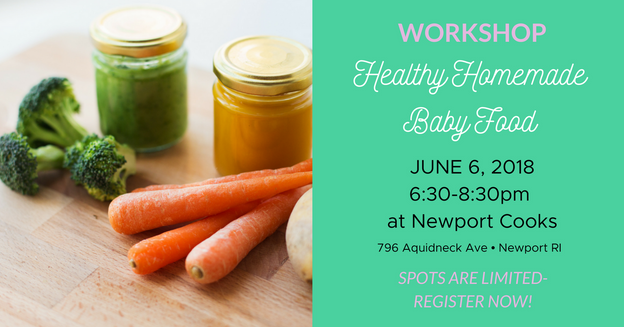
I mentioned in my last post on baby feeding that a lot has changed since I first learned about infant nutrition in my lifecycle nutrition class back in college nearly ten years ago, now. One of the biggest changes? Introduction of allergenic foods.
Years ago in the early 2000’s, when instance of food allergies began to rise, pediatricians responded by recommending parents avoid allergenic foods with their babies until age one or later, especially if there was a history of allergies in the family (dairy after one- this is still true for liquid milk; eggs after two, peanuts, nuts and fish until three or later). What happened? The estimated prevalence of food allergy in the United States nearly doubled (from 3.4% to 5.1%) between 1999 and 2009, and the estimated prevalence of peanut allergy tripled (from 0.4% to 1.4%) between 1999 and 2011. (source) Scary.
In the meantime, several large studies finding strong evidence that babies at high risk peanut allergies are actually LESS likely to develop an allergy if they are regularly fed peanut-containing foods in the first year of life, starting as early as 4-6 months. The LEAP study is at the forefront of this research. The LEAP study “… demonstrated that regular peanut consumption begun in early infancy and continued until age 5 reduced the rate of peanut allergy in at-risk infants by 80% compared to non-peanut-consumers.” (source)
Similar studies have been done on egg whites, showing a higher risk the later the food was introduced. In 2008, pediatricians in the US officially changed their stance on introducing allergenic foods; recommending early introduction around 6 months (close to the introduction of solid foods). Recently, the NIH also released a statement regarding introducing peanut products early to avoid allergies.
The Recommendations
In 2017, the Academy of Allergy, Asthma and Immunology released an information packet regarding guidelines for introducing allergens. They echo the AAP’s recommendations for introducing allergens earlier, rather than later, with some specific guidelines:
-after other tolerated solids have already been introduced
-at home
-if tolerated, adding one new food every 3-5 days
The American Academy of Pediatrics also recommends prevention measures for children who are more susceptible (with family history), breastfeeding until 6 months or choosing a low-allergy (no cow’s dairy or soy) formula; waiting to introduce solid foods until 4-6 months and waiting on cow’s milk until one year.
The Top 8 allergens include: milk, eggs, fish, shellfish, peanuts, tree nuts, wheat and soy.

Enjoy a smoothie with almond butter, goat milk yogurt, spinach and a ton of goodness!
Our Approach
We decided early on that we would follow the AAP’s guidelines and cautiously introduce allergenic foods early. We did decide however, that we would only introduce allergenic foods so slowly– I believe a varied diet is important, even from the beginning, so after the first couple weeks, allergenic foods aside, we didn’t wait the 3-5 days before introducing a new food.
So what was her first allergenic food? We started with the most innocuous, for our family, with our own personal history (milk products, egg, tree nuts, fish, shellfish) and the foods we eat most often. We waited on the foods that we have direct family history of reactions; though neither are confirmed food allergies; I react to wheat to some extent and we have family history of celiac; I also react to soy. Nick and Sage are allergic to corn. So far, she has enjoyed cow’s dairy (cheese), goat dairy (yogurt), tree nuts (almonds and cashews), fish (multiple varieties), and shellfish (shrimp). We also introduced sesame, a highly allergenic food, and she did fine.
For wheat and soy, we treaded more lightly. A small piece of sprouted ancient grain wheat toast a couple days in a row proved reaction-free; and a taste of soy sauce in some homemade korean food tested soy reactions (not the ideal, I know- but it worked at the time!). We know these foods won’t be staples in our diet, but frequent exposure is important to avoid allergic reactions.
Full disclosure: We still haven’t introduced peanuts. We will, this week, before her 7-month birthday. But there’s reasoning behind it. First, we simply don’t eat peanuts often, so it just happened to come towards the end- but it didn’t change our stance on introducing allergens early. The one reaction she did have? Egg whites. Though it was only a skin reaction (red wherever the egg white touched her skin), it was a reaction nonetheless. So we decided to move forward with all other allergens first, as egg allergy increases the risk of peanut allergy.
What to look for:
Allergic reactions can come in many forms, so it’s important to be on the lookout for what might be considered an allergic reaction.
Megan Garcia outlines possible reactions:
“Signs of a mild allergic response:
A new rash
Hives around the mouth or face
Signs of a severe allergic response:
Lip swelling
Vomiting
Hives or welts all over the body
Face or tongue swelling
Trouble breathing
Wheezing
Coughing
Change in skin color to pale blue
Sudden tiredness”
Food allergies often occur on the second or third exposure, so it’s important to introduce early and often.
So what do you do if baby has an allergic reaction?
There is no cure for baby allergies, however many babies or children grow out of food allergies by 3-6 years.
Talk to your pediatrician about seeing an allergist, they often do food challenges in-office, to determine true reactions. A full allergy panel is usually not recommended, as Megan reminds parents, as babies often ‘grow out’ of allergies within the first year.
It’s actually not recommended to remove foods that have a positive allergy test (unless a severe reaction is occurring), to give the body a chance to develop tolerance.
Well-tolerated foods should be offered regularly, and foods with mild reactions may be re-introduced after a time to re-test reaction.
What else helps?
Probiotics and fermented foods help to increase the good bacteria in the gut; supporting immune health. Bifidobacteria specifically has been shown to be beneficial.
Anti-inflammatory foods like omega-3 fatty acids and antioxidant rich foods (like foods rich in vitamin c, and e) are also beneficial.
More recommendations: Managing Baby Allergies
I, for one am fascinated by the recent research! Did you introduce allergens to your baby early?
Local Mamas: learn more and ask me all the questions! I’m sharing so much more about how to practically feed baby- purees, self-feeding, introducing different flavors, spices and more- in my healthy homemade baby food workshop at Newport Cooks! Join me

Additional Resources:
https://www.uptodate.com/contents/introducing-highly-allergenic-foods-to-infants-and-children
https://jamanetwork.com/journals/jama/article-abstract/2553431?redirect=true
https://www.aap.org/en-us/advocacy-and-policy/aap-health-initiatives/HALF-Implementation-Guide/Age-Specific-Content/Pages/Infant-Food-and-Feeding.aspx
Leave a Reply Cancel reply
5-day series: how to get started with meal prep for easier meals
free email series
©️ 2025 Kristin Dovbniak for Healthy Mama Kris | Template by Maya Palmer Designs | Privacy Policy | Terms
